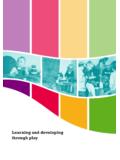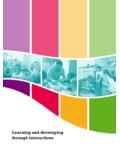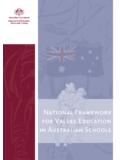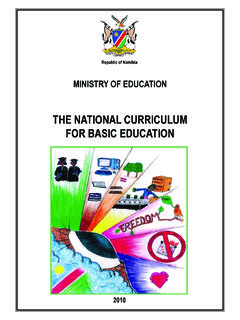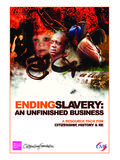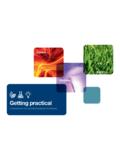Transcription of Key messages from the research papers - ncca.biz
1 key messages from the research papers NCCA 2009 National Council for Curriculum and Assessment24 Merrion Square, Dublin 3 key messages from the research papersAistear: the Early Childhood Curriculum framework Introduction Early childhood in Ireland is from birth to six years. During this period, children can spend time in different settings and adults in these settings can use different approaches to help them learn and develop. This variety helps to meet the different needs of children and their families at different times in their lives. Ireland has changed a lot in recent years. Families tend to be smaller with both parents working in many cases. The population is more diverse than ever before. There have also been changes in policy and legislation (see below). These developments highlight the importance of and children s right to learning and development opportunities based on their interests, strengths, culture, and specific needs.
2 Aistear: the Early Childhood Curriculum framework plays an important role in giving children these opportunities. Some policy and legislative developments The Child Care Act (1991) Ireland s ratification of the United Nations Convention on the Rights of the Child (1992) The Child Care (Pre-School Services) Regulations (1996, 2006) The Primary School Curriculum (1999) The National Children s Strategy (2000) The National Play Policy (2003) S olta , the National Quality framework for Early Childhood Education (2006)Legislation on education, and the needs and rights of children with special educational needs (1998; 2004; 2005).A review of researchMuch of the research used to develop Aistear is summarised in four papers :Perspectives on the relationship between education and care in early childhood (Hayes, 2007) 1. Children s early learning and development (French, 2007)2.
3 Play as a context for early learning and development (Kernan, 2007)3. Supporting children s early learning and development through formative assessment (Dunphy, 2008). 4. These papers are on the NCCA website at This booklet summarises each paper and concludes with an overview of the key messages . Paper 1: The relationship between education and careThe paper Perspectives on the relationship between education and care in early childhood (Hayes, 2007) discusses how the development of the education and childcare sectors in Ireland as separate creates challenges in working towards quality early years provision. The paper also looks at what the terms education and care mean and suggests how greater balance between the two might be brought about. An important message in the paper is that learning and development can take place in day-to-day caring routines and relationships.
4 At the same time, education can be provided in a caring way. The paper describes this approach as a nurturing pedagogy which emphasises children s feelings and dispositions such as motivation, confidence, perseverance, and how they see themselves as learners. It promotes communication, thinking and problem-solving skills. The paper emphasises the key role the adult plays in a nurturing pedagogy. He/she encourages playful interactions and behaviours, explorations, conversations, and collaborative learning. The adult also observes, reflects on and interprets children s words and actions. This is necessary for planning future learning opportunities. 4 key messages from the research papersAistear: the Early Childhood Curriculum framework In summary, the paper highlights how early years learning environments that are well planned with a balance between care and education and have well-trained, confident and supported staff lead to positive outcomes for 2: Early learning and development The paper Children s early learning and development (French, 2007) describes children as competent young learners, able to make choices and decisions, who learn with and from each other at home, in early childhood settings and in their communities.
5 Through these different relationships children learn about their world. Trust, respect, love, and care are at the heart of relationships which enable children to grow, learn and develop. Opportunities for co-operation, playfulness, problem-solving, and conflict resolution are all valued. Another message in the paper is that children constantly make connections between their new learning and previous learning. Much of this happens through language and play with others. Using these children build a sense of identity and belonging to their family, settings and community. They learn from others, and think about and learn from the effects of their actions and words. They use their senses, physical activity, imagination, and creativity. This learning and development is enhanced by challenging and interesting places, indoor and outdoor, to explore and investigate.
6 A balance between adult-initiated and child-initiated activities in these places is also important. According to the research presented in the paper learning is enhanced when parents/family and the early childhood setting work together. By being involved in their children s early learning, parents can improve their children s motivation to learn. In summary, the paper emphasises active learning, relationships, play, language, and meaningful experiences as priorities for supporting children s early learning and development. Paper 3: PlayThe paper Play as a context for early learning and development (Kernan, 2007) explains that all children from birth to six years have a right to time and space to play and to benefit from their play experiences. Play is voluntary, spontaneous and meaningful. When playing children can experience risk within safe and secure boundaries.
7 They can often concentrate for long periods of time too. Play is also often very social children enjoy playing with other children and with adults. Above all, play is fun and an important part of children s learning and development. The paper refers to the many types of play exploratory, constructive, creative, pretend, fantasy, socio-dramatic, physical, and language and word play. Another message in this paper is that the physical environment, the people and objects in it and the time available influence how children play and the benefits they get from play. Children s individual characteristics and backgrounds also influence how and what they play. The paper describes the adult s important role. Play changes as children grow and develop and so too does this role. For example, the familiar adult offers babies and young toddlers a secure physical and emotional base which encourages them to explore.
8 He/she creates opportunities for toddlers to move, and young children to role-play and pretend. In order to support and extend children s play the skilled adult observes, listens and interprets children s play. He/she provides interesting and challenging indoor and outdoor spaces with lots of time for play. Explaining the importance of play to parents is also necessary. In summary, good quality play experiences impact positively on children s learning and messages from the research papersAistear: the Early Childhood Curriculum framework Paper 4: Formative assessment The paper Supporting children s early learning and development through formative assessment (Dunphy, 2008) describes assessment as collecting, documenting, reflecting on, and using information to develop portraits of children as learners. Formative assessment helps adults to see what children are thinking and feeling, what they understand and can do.
9 The adult uses the assessment information to plan future learning experiences, and to make learning interesting and successful for children. According to the paper assessment should focus on children s development of dispositions, attitudes and values as well as their skills, knowledge and understandings. Assessment happens as part of everyday activities, tasks and routines. It is sensitive and respectful to children. In this way, the paper illustrates how assessment shows the richness of children s learning and development as well as identifying aspects that might benefit from attention and specific supports. The adult assesses by watching, listening, talking with, and empathising with children. Over time, children too can assess their own learning. The paper refers to a narrative approach to assessment describing early learning using notes, stories, samples of work , and photographs.
10 This offers a way of building a rich picture of early learning and development over time. The paper highlights how this approach can be demanding yet rewarding. In summary, the paper emphasises the importance of assessment in supporting children s early learning and development. Understanding how children learn and develop is an important foundation for good assessment which benefits both children and adults. Common messagesSo what does the research tell us about helping children to learn and develop here in Ireland? This section uses two questions to identify key messages from across the research papers . Some of the messages are from individual papers while others are common to a number of the papers . What does the research tell us about children as learners in early childhood? Children are competent, confident and capable learners, able to make choices and decisions.

